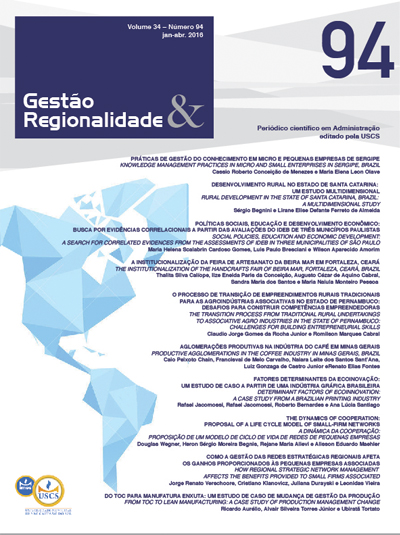Productive agglomerations in the coffee industry in Minas Gerais, Brazil
DOI:
https://doi.org/10.13037/gr.vol32n94.2890Abstract
The aim of this study was to analyze the concentration of the coffee industry in the municipalities of Minas Gerais with potential for structuring clusters between 2002 and 2010. The state tax revenue was used to measure the average Normalized Concentration Index (NCI) of the sector among municipalities which, in turn, were filtered by the amount of participation in employment and establishments. The municipalities of Capelinha and Varginha were listed as potential clusters for the coffee industry because only they presented NCI above average, at least five establishments and at least 1% of the jobs in the sector during the period analyzed.Downloads
Download data is not yet available.
Downloads
Published
2016-03-29
How to Cite
Chain, C. P., Carvalho, F. de M., Sant`Ana, N. L. dos S., Castro Junior, L. G. de, & Fontes, R. E. (2016). Productive agglomerations in the coffee industry in Minas Gerais, Brazil. Gestão & Regionalidade, 32(94). https://doi.org/10.13037/gr.vol32n94.2890
Issue
Section
Articles
License
Autores que publicam nesta revista concordam com os seguintes termos:
- Autores mantém os direitos autorais e concedem à revista o direito de primeira publicação, com o trabalho simultaneamente licenciado sob a https://creativecommons.org/
licenses/by-nc-nd/4.0/, permitindo o compartilhamento do trabalho com reconhecimento da autoria do trabalho e publicação inicial nesta revista. - Autores têm autorização para assumir contratos adicionais separadamente, para distribuição não-exclusiva da versão do trabalho publicada nesta revista (ex.: publicar em repositório institucional ou como capítulo de livro), com reconhecimento de autoria e publicação inicial nesta revista.
- Autores têm permissão e são estimulados a publicar e distribuir seu trabalho online (ex.: em repositórios institucionais ou na sua página pessoal) a qualquer ponto antes ou durante o processo editorial, já que isso pode gerar alterações produtivas, bem como aumentar o impacto e a citação do trabalho publicado (Veja O Efeito do Acesso Livre).





















